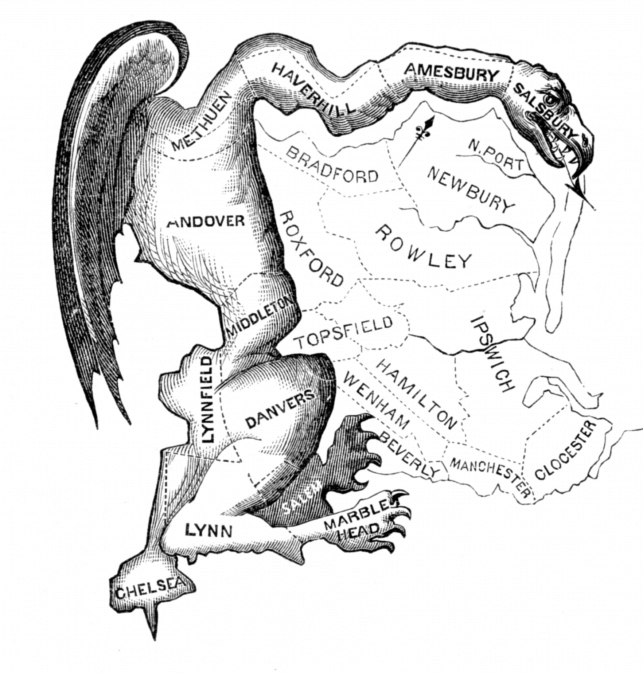
I’ve been hearing the word “gerrymandering” a lot in the news lately. For example, a North Carolina court ruled that its state’s partisan gerrymander was unconstitutional, and the FiveThirtyEight website just finished a six-part podcast series called The Gerrymandering Project. It’s a hot issue in American politics right now, but “gerrymandering” also struck me as an odd word, and I started wondering about its origin, which turned out to be interesting.
Although most other democracies are also at least theoretically susceptible to gerrymandering, it appears to have started in the good old U. S. of A. Sorry.
What Is Gerrymandering?
Gerrymandering is fiddling with the boundaries of electoral districts to give your group some kind of advantage. Patient zero for gerrymandering was Massachusetts all the way back in 1812 when the governor signed a bill that redrew the state’s district lines to give an advantage to the Democratic-Republican party over the competing Federalist party. That governor’s name was Elbridge Gerry.
Who Coined the Name ‘Gerrymandering’?
The Federalists were outraged and, according to Smithsonian Magazine, a Federalist dinner party conversation led to the idea that the shape of one new district resembled a monster. One guest, Elkanah Tisdale, drew a long-necked, clawed monster over the map, causing another guest to comment that it looked like a salamander, and then the poet Richard Alsop commented that no—it was not a salamander but a “Gerry-mander” in honor of governor Gerry. Other sources credit Federalist newspaper editors, including Nathan Hale, with inventing the term, but either way, the cartoon appeared in the “Boston Gazette” and solidified the name and concept in the American imagination. By 1848, the word had found dictionary acceptance.
How to Pronounce ‘Gerrymander’
And you’ll notice that the term was originally pronounced “gary-mander” to reflect the pronunciation of Governor Gerry’s name, but given that the first radio stations didn’t start broadcasting until the early 1900s, there was no mass media to tell people how to pronounce the word they were reading, and people began to interpret the word as “jerry-mander,” so that’s what we call it today.
How Gerrymandering Works
The two most common methods of gerrymandering are called “cracking” and “packing.”
Cracking takes certain kinds of voters—those of a certain race or political party—and spreads them out over many districts so they don’t have enough votes in any of them to win.
Packing take all those voters and instead packs them into one malformed district so they win that one district, but no others.
According to Elbridge Gerry’s descendants, he was reluctant to sign the gerrymandering bill, so unfortunately, he’s probably rolling, cracking, and packing in his grave to have his legacy be that his name is associated with this villainous political practice.
Image via Wikimedia Commons: Public Domain, Link
Mignon Fogarty is Grammar Girl and the founder of Quick and Dirty Tips. Check out her New York Times best-seller, “Grammar Girl’s Quick and Dirty Tips for Better Writing.”
Tidak ada komentar:
Posting Komentar